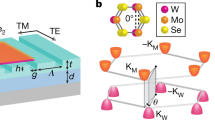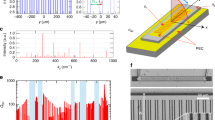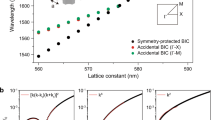Abstract
Small semiconductor lasers that can be integrated on a chip are essential for a wide range of optical applications, including optical computing, communication and sensing. Practical laser applications have only been developed with direct-bandgap materials because of a general belief that lasing action from indirect-bandgap materials is almost impossible. Here we report unexpected indirect-bandgap transition lasing in an ultra-thin WS2 disk. We demonstrate that a 50-nm-thick WS2 disk offers efficient optical gain and whispering gallery modes that are sufficient for lasing action. As a result, the WS2 disk exhibits indirect transition lasing, even under continuous-wave excitation at room temperature. Our experimental results are in close agreement with theoretical modelling for phonon-assisted photon lasing. The results derived from external cavity-free ultra-thin WS2 layers offer a new direction for van-der-Waals-material-based nanophotonics and introduce the possibility for optical devices based on indirect-bandgap materials.
This is a preview of subscription content, access via your institution
Access options
Access Nature and 54 other Nature Portfolio journals
Get Nature+, our best-value online-access subscription
$29.99 / 30 days
cancel any time
Subscribe to this journal
Receive 12 print issues and online access
$209.00 per year
only $17.42 per issue
Buy this article
- Purchase on Springer Link
- Instant access to full article PDF
Prices may be subject to local taxes which are calculated during checkout




Similar content being viewed by others
Data availability
All the relevant data that support the findings of this study are available from the corresponding authors on reasonable request.
References
Ma, R.-M. & Oulton, R. F. Applications of nanolasers. Nat. Nanotechnol. 14, 12–22 (2019).
Ning, C.-Z. Semiconductor nanolasers. Phys. Status Solidi B 247, 774–788 (2010).
Pavesi, L. Will silicon be the photonic material of the third millenium? J. Phys. Condens. Matter 15, R1169 (2003).
Canham, L. Gaining light from silicon. Nature 408, 411–412 (2000).
Soref, R. Mid-infrared photonics in silicon and germanium. Nat. Photon. 4, 495–497 (2010).
Liang, D. & Bowers, J. E. Recent progress in lasers on silicon. Nat. Photon. 4, 511–517 (2010).
Rong, H. et al. An all-silicon Raman laser. Nature 433, 292–294 (2005).
Rong, H. et al. A continuous-wave Raman silicon laser. Nature 433, 725–728 (2005).
Takahashi, Y. et al. A micrometre-scale Raman silicon laser with a microwatt threshold. Nature 498, 470–474 (2013).
Chen, M., Tsai, C. & Wu, M. Optical gain and co-stimulated emissions of photons and phonons in indirect bandgap semiconductors. Jpn J. Appl. Phys. 45, 6576 (2006).
Tsai, C.-Y. Theoretical model for the optical gain coefficient of indirect-band-gap semiconductors. J. Appl. Phys. 99, 053506 (2006).
Escalante, J. M. & Martínez, A. Theoretical study about the gain in indirect bandgap semiconductor optical cavities. Physica B 407, 2044–2049 (2012).
Trupke, T., Green, M. A. & Würfel, P. Optical gain in materials with indirect transitions. J. Appl. Phys. 93, 9058–9061 (2003).
Bao, S. et al. Low-threshold optically pumped lasing in highly strained germanium nanowires. Nat. Commun. 8, 1845 (2017).
Pilon, F. A. et al. Lasing in strained germanium microbridges. Nat. Commun. 10, 2724 (2019).
Camacho-Aguilera, R. E. et al. An electrically pumped germanium laser. Opt. Express 20, 11316–11320 (2012).
Elbaz, A. et al. Ultra-low-threshold continuous-wave and pulsed lasing in tensile-strained GeSn alloys. Nat. Photon. 14, 375–382 (2020).
Wirths, S. et al. Lasing in direct-bandgap GeSn alloy grown on Si. Nat. Photon. 9, 88–92 (2015).
Pavesi, L., Dal Negro, L., Mazzoleni, C., Franzo, G. & Priolo, D. F. Optical gain in silicon nanocrystals. Nature 408, 440–444 (2000).
Ye, Y. et al. Monolayer excitonic laser. Nat. Photon. 9, 733–737 (2015).
Li, Y. et al. Room-temperature continuous-wave lasing from monolayer molybdenum ditelluride integrated with a silicon nanobeam cavity. Nat. Nanotechnol. 12, 987–992 (2017).
Ge, X., Minkov, M., Fan, S., Li, X. & Zhou, W. Laterally confined photonic crystal surface emitting laser incorporating monolayer tungsten disulfide. npj 2D Mater. Appl. 3, 16 (2019).
Reeves, L., Wang, Y. & Krauss, T. F. 2D material microcavity light emitters: to lase or not to lase? Adv. Opt. Mater. 6, 1800272 (2018).
Paik, E. Y. et al. Interlayer exciton laser of extended spatial coherence in atomically thin heterostructures. Nature 576, 80–84 (2019).
Liu, Y. et al. Room temperature nanocavity laser with interlayer excitons in 2D heterostructures. Sci. Adv. 5, eaav4506 (2019).
Lohof, F. et al. Prospects and limitations of transition metal dichalcogenide laser gain materials. Nano Lett. 19, 210–217 (2018).
Gutiérrez, H. R. et al. Extraordinary room-temperature photoluminescence in triangular WS2 monolayers. Nano Lett. 13, 3447–3454 (2013).
Verre, R. et al. Transition metal dichalcogenide nanodisks as high-index dielectric Mie nanoresonators. Nat. Nanotechnol. 14, 679–683 (2019).
Zhang, X. et al. Guiding of visible photons at the ångström thickness limit. Nat. Nanotechnol. 14, 844–850 (2019).
van de Groep, J. et al. Exciton resonance tuning of an atomically thin lens. Nat. Photon 14, 426–430 (2020).
Desai, S. B. et al. Strain-induced indirect to direct bandgap transition in multilayer WSe2. Nano Lett. 14, 4592–4597 (2014).
Yuan, L., Wang, T., Zhu, T., Zhou, M. & Huang, L. Exciton dynamics, transport, and annihilation in atomically thin two-dimensional semiconductors. J. Phys. Chem. Lett. 8, 3371–3379 (2017).
Burt, D. et al. Strain-relaxed GeSn-on-insulator (GeSnOI) microdisks. Opt. Express 29, 28959–28967 (2021).
Wu, K. et al. All-optical phase shifter and switch near 1,550 nm using tungsten disulfide (WS2) deposited tapered fiber. Opt. Express 25, 17639–17649 (2017).
Zhou, T. et al. Continuous-wave quantum dot photonic crystal lasers grown on on-axis Si (001). Nat. Commun. 11, 977 (2020).
Frost, T., Banerjee, A., Sun, K., Chuang, S. L. & Bhattacharya, P. InGaN/GaN quantum dot red (λ = 630 nm) laser. IEEE J. Quantum Electron. 49, 923–931 (2013).
Hayenga, W. E. et al. Second-order coherence properties of metallic nanolasers. Optica 3, 1187–1193 (2016).
Liu, H., Wang, T., Wang, C., Liu, D. & Luo, J. Exciton radiative recombination dynamics and nonradiative energy transfer in two-dimensional transition-metal dichalcogenides. J. Phys. Chem. C 123, 10087–10093 (2019).
Mylnikov, V. et al. Lasing action in single subwavelength particles supporting supercavity modes. ACS Nano 14, 7338–7346 (2020).
Berkdemir, A. et al. Identification of individual and few layers of WS2 using Raman spectroscopy. Sci. Rep. 3, 1755 (2013).
Acknowledgements
This work was supported by the National Research Foundation of Korea (NRF-2019R1A2C2003313) and the National R&D Program through the National Research Foundation of Korea (NRF) funded by the Ministry of Science and ICT (2020M3H3A1105796, 2021M3F3A2A03017083). We acknowledge support provided by the Samsung Science and Technology Foundation (SSTF-BA1902-03) and a Korea University Grant. Y.D.K. acknowledges support from the NRF of Korea (2021K1A3A1A32084700, 2021R1A2C2093155). Electron-beam lithography systems were investigated in the Multidimensional Materials Research Center at Kyung Hee University (2021R1A6C101A437).
Author information
Authors and Affiliations
Contributions
S.-H.G. conceptualized and supervised the study. J.S. and S.-H.G. performed all data analysis and visualization. J.S., S.P. and Y.D.K. fabricated the sample structures. J.S., J.S.M., D.S. and S.W.L. conducted the optical experiments and data collection. S.-H.G., J.S. and H.C. developed the theoretical model. S.-H.G. and J.S. wrote the original draft. S.-H.G., J.-H.K. and Y.D.K. reviewed and edited the final manuscript.
Corresponding author
Ethics declarations
Competing interests
The authors declare no competing interests.
Peer review
Peer review information
Nature Photonics thanks Di Liang and the other, anonymous, reviewer(s) for their contribution to the peer review of this work.
Additional information
Publisher’s note Springer Nature remains neutral with regard to jurisdictional claims in published maps and institutional affiliations.
Supplementary information
Supplementary Information
Supplementary Figs. 1–14 and Table 1.
Rights and permissions
Springer Nature or its licensor holds exclusive rights to this article under a publishing agreement with the author(s) or other rightsholder(s); author self-archiving of the accepted manuscript version of this article is solely governed by the terms of such publishing agreement and applicable law.
About this article
Cite this article
Sung, J., Shin, D., Cho, H. et al. Room-temperature continuous-wave indirect-bandgap transition lasing in an ultra-thin WS2 disk. Nat. Photon. 16, 792–797 (2022). https://doi.org/10.1038/s41566-022-01085-w
Received:
Accepted:
Published:
Issue Date:
DOI: https://doi.org/10.1038/s41566-022-01085-w
This article is cited by
-
Deep learning in two-dimensional materials: Characterization, prediction, and design
Frontiers of Physics (2024)



